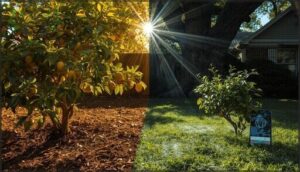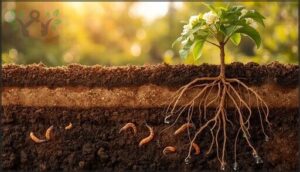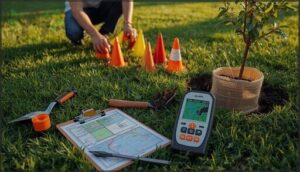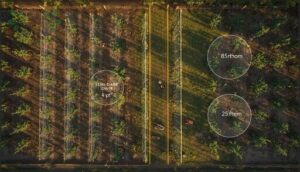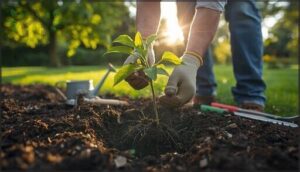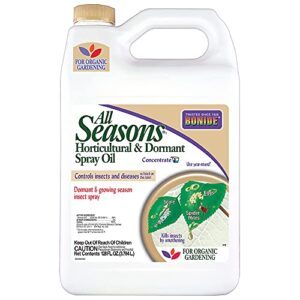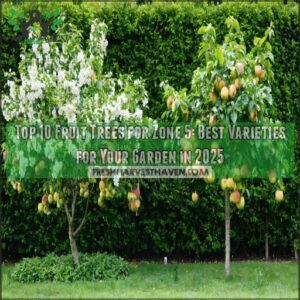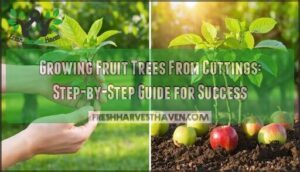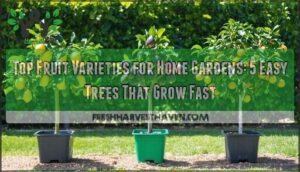This site is supported by our readers. We may earn a commission, at no cost to you, if you purchase through links.
Most home gardeners who plant their first fruit tree expect to wait seven years for a decent harvest, but that timeline often reflects poor variety selection rather than biological necessity. You can cut that waiting period in half by choosing grafted, self-pollinating cultivars bred for rapid maturity and disease resistance.
Growing fruit trees at home isn’t about luck or having a green thumb—it’s about understanding what your climate demands, how to prepare soil that drains properly without drying out, and which maintenance practices actually move the needle.
The difference between a struggling sapling and a thriving tree often comes down to decisions you make before you even dig the hole.
Table Of Contents
- Key Takeaways
- Choosing The Best Fruit Trees for Home Gardens
- Preparing Your Planting Site and Soil
- Planting and Caring for Fruit Trees
- Top 5 Tools and Guides for Growing Fruit Trees
- Frequently Asked Questions (FAQs)
- What is the easiest fruit tree to grow at home?
- What month should fruit trees be planted?
- What is the best fruit to grow for beginners?
- Which fruit trees should not be planted together?
- How long does it take for a tree to produce fruit?
- Can you grow fruit trees at home?
- What are the best fruit trees to grow?
- How to successfully grow fruit trees?
- How do I choose the best fruit trees to grow?
- Are fruit trees easy to grow?
- Conclusion
Key Takeaways
- You can harvest fruit in 3-4 years instead of seven by selecting grafted, self-pollinating cultivars bred for rapid maturity and matching them to your specific climate’s chill hour requirements.
- Successful fruit tree establishment hinges on pre-planting decisions—disease-resistant varieties, proper site selection with 6-8 hours of sunlight, well-draining soil amended with organic matter, and adequate spacing for mature tree dimensions.
- The graft union must sit 3-6 inches above soil level to preserve rootstock benefits and prevent disease, while deep watering to the drip line and 2-4 inches of mulch (never touching bark) drive healthy root development.
- Bare-root trees cost less but show only 40-60% survival rates during optimal planting windows, whereas container-grown trees exceed 80% survival with year-round planting flexibility despite higher initial investment.
Choosing The Best Fruit Trees for Home Gardens
Picking the right fruit tree makes all the difference between a thriving harvest and years of frustration. You’ll need to think about factors like disease resistance, climate compatibility, pollination needs, and how much space you actually have to work with.
Let’s walk through the key decisions that will set you up for success from the start.
Selecting Disease-Resistant and Beginner-Friendly Varieties
When you’re starting out, disease-resistant varieties make all the difference. Liberty and William’s Pride apples show strong resistance to scab and rust, while Moonglow pears fight off fire blight naturally. Asian pears and native mulberries rarely encounter problems, making them ideal beginner-friendly fruit trees.
Choosing varieties with strong disease resistance can reduce the need for chemical treatments. Choose grafted, self-pollinating cultivars adapted to your region, and you’ll spend less time managing issues and more time enjoying your harvest.
Matching Fruit Trees to Your Climate and Chill Hours
Beyond disease resistance, matching fruit trees to your climate and chill hours determines success. Chill hours—time spent below 45°F—trigger proper dormancy. Apples need 200–1,000 hours; peaches require 250–1,000; citrus thrives with minimal chilling in zones 10–13.
Climate change is reducing chill hour accumulation by up to 30% in some regions by 2050, so:
- Check your hardiness zone and local chill hour averages
- Select low-chill cultivars for warming or mild climates
- Reference regional recommendations from extension services
- Match varieties to documented climate data for best yields
Insufficient winter cold can cause delayed and erratic blooming, impacting fruit set.
Understanding Pollination and Cross-Pollination Requirements
After matching your tree to climate, you’ll need to understand pollination. Self-pollinating varieties like peaches show self-fruitfulness rates above 95%, eliminating the need for a second tree.
However, approximately 10% of apples are self-fertile—most benefit from cross-pollination within 50–100 feet of compatible varieties, boosting fruit set by up to 30%. Inadequate pollination can reduce yields by 65% in apples, so plan your plantings carefully.
Evaluating Tree Size and Space for Your Garden
Once you’ve sorted out pollination, it’s time to think about space. Dwarf varieties suit compact gardens, reaching just 4–6 feet tall with minimal root spread. Semi-dwarf trees grow 10–16 feet and balance yield implications with manageable size. Standard fruit trees tower at 25–30 feet, demanding significant space but rewarding patience with abundant harvests.
Choosing the right location means matching tree varieties to your garden’s reality:
- Dwarf trees leverage space efficiency in urban yards
- Semi-dwarf options balance productivity and accessibility
- Standard varieties require 25-foot spacing for best growth
Proper site selection prevents overcrowding and ensures healthy, productive trees for decades.
Preparing Your Planting Site and Soil
Before you plant your fruit tree, you need to prepare the site properly to give it the best chance at thriving for decades. The right location means more than just finding an empty spot in your yard—it involves evaluating sunlight, soil conditions, potential obstacles, and space for growth.
Let’s walk through the key factors that will set your tree up for long-term success.
Assessing Sunlight and Avoiding Shaded Areas
Most fruit trees need 6 to 8 hours of full sunlight daily to thrive. Yard orientation matters—south-facing sites receive maximum sunlight exposure in the northern hemisphere.
Start by mapping shadow patterns throughout the day, especially between 10 a.m. and 4 p.m. when sunlight is strongest. Use smartphone apps or direct observation as sunlight assessment tools.
Avoid planting near buildings or large trees that create shade, and monitor seasonal sunlight changes to identify best planting sites for choosing the right location.
Improving Soil Fertility and Drainage for Fruit Trees
Before you plant, test your soil conditions to understand fertility and pH levels. Healthy soil preparation sets the foundation for decades of fruit production.
- Add compost or manure to boost organic matter and microbial activity, improving nutrient availability
- Build raised beds or incorporate coarse sand into heavy clay for better soil drainage
- Plant cover crops like clover to fix nitrogen naturally and reduce compaction impact
- Apply organic amendments at recommended rates to improve soil structure without over-fertilizing
- Install subsurface drainage techniques such as French drains in persistently wet areas
Checking for Underground Utilities and Site Obstacles
Before you dig, always Call Before Digging by contacting 811 to prevent striking buried lines. Utility Marking Accuracy varies by state, so wait for locators to flag your site.
Safe Digging Practices require hand tools near marked zones, while GPR Technology detects non-metallic pipes.
This Damage Prevention step protects you during the Planting Process and complements your Soil Preparation efforts for Planting Fruit Trees.
Planning for Mature Tree Size and Spacing
Your tree’s mature dimensions dictate how much room you’ll need for decades ahead. Root spread often reaches two to four times the canopy diameter, so a 15-foot-wide crown might send roots 30 to 60 feet outward.
Consider these spacing impact principles for your orchard layout:
- Dwarf trees need 6–8 feet apart; semi-dwarf varieties require 15 feet
- Standard apples demand 25 feet minimum spacing
- Urban adaptations allow espalier planting at 4–5 feet intervals
- Select tree varieties matching your available footprint
Smart fruit tree selection prevents crowding and nutrient competition.
Planting and Caring for Fruit Trees
Now that you’ve chosen the right tree and prepared your site, it’s time to get your hands dirty. The way you plant and care for your fruit tree in those first few years will determine whether it thrives or struggles down the line.
Let’s walk through the essential techniques that’ll set you up for a lifetime of homegrown fruit.
Planting Bare-Root Versus Container-Grown Trees
When planting fruit trees, you’ll choose between bareroot trees and potted trees—each with distinct tradeoffs. Bare-rooted trees cost less but require careful handling to avoid root desiccation and have survival rates around 40% overall, peaking at 60% during the best planting season (late fall to early spring).
Container-grown options exceed 80% survival rates, offer year-round planting flexibility, and support faster root establishment, though they cost slightly more.
Proper Planting Depth and Graft Union Placement
Getting the depth right during tree planting makes all the difference. Your grafted fruit tree’s graft line—the swollen knob where scion meets rootstock—should sit 3 to 6 inches above the soil. Burying it triggers scion rooting, which cancels the rootstock’s dwarfing effect and invites union diseases.
Plant your grafted fruit tree with the graft line 3 to 6 inches above soil to preserve rootstock benefits and prevent disease
Since soil settling can drop bareroot trees or potted trees several inches after watering, always plant slightly high.
Watering Techniques and Mulching for Healthy Roots
Once your tree settles in, deep watering drives root systems downward and strengthens drought tolerance. Semi-dwarf varieties need roughly 16 gallons daily during summer growth, so soak slowly to the drip line rather than sprinkling the trunk.
Apply 2 to 4 inches of organic mulch in a donut ring—never piled against bark—to lock in soil moisture and boost root health.
Pruning, Staking, and Regular Maintenance Practices
Beyond watering, you’ll keep trees productive through targeted fruit tree care. Annual pruning techniques regulate vigor and fruit size, while staking methods prevent wind damage in young plantings. Follow seasonal schedules for balanced tree maintenance:
- Prune dormant trees in late winter to maintain 2.5-meter heights and stimulate 200+ new shoots yearly.
- Disinfect tools between cuts during disease management to stop fireblight spread.
- Apply preventative sprays at pink bud, petal fall, and first cover stages for garden maintenance.
Top 5 Tools and Guides for Growing Fruit Trees
Growing fruit trees successfully requires more than just knowledge—it also depends on having the right tools and resources at your fingertips. From detailed planting guides to protective barriers that keep pests away, these products can simplify your work and improve your results.
Below are five essential tools and guides that will help you cultivate healthy, productive fruit trees from the start.
1. Grow Fruit Trees Fast Guide
When you’re ready to accelerate your orchard timeline, Susan Poizner’s Grow Fruit Trees Fast offers 96 pages of practical, science-backed methods for beginner-friendly fruit trees.
This $4.99 digital guide covers rapid planting techniques, species selection, nutrient management, and care practices that can shorten your harvest timeline by 1.5 years.
You’ll learn how bare-root trees increase growth speed by 35% and discover organic approaches to fruit tree care. It’s particularly valuable for home growers seeking easy fruit tree cultivation with measurable harvest outcomes.
Best For: Beginner gardeners and home growers who want to shorten their wait time for fruit and learn natural, science-backed methods without spending years on trial and error.
- Bare-root planting techniques can boost growth by 35% and cut harvest timelines by 1.5 years, with dwarf varieties producing fruit in as little as 2–4 years.
- Covers the full cycle from soil prep to pruning and pest management, with proven methods that increase fruit production by 20–38% and tree survival rates above 92%.
- At $4.99 for 96 pages, it’s an affordable entry point written by an award-winning educator with practical, field-tested advice.
- Focuses on temperate fruit trees, so it won’t help much if you’re growing citrus or live in a tropical climate.
- Frequent references to external courses and websites can feel like upsells, which some readers find distracting.
- It’s a general overview, so you might need additional resources for deep dives into specific tree varieties or regional challenges.
2. Growing Urban Orchards Fruit Tree Care
Urban orchards require distinct care strategies. Susan Poizner’s Growing Urban Orchards covers pest management, soil fertility, and water strategies specific to city environments.
You’ll find site planning techniques for limited space, species selection for disease resistance, and tree care protocols that reduce maintenance by 30%.
The guide includes case studies from over 650 established orchards, offering beginner gardeners practical fruit tree maintenance routines. It’s particularly useful if you’re managing smaller lots where spacing, irrigation timing, and pollinator access affect long-term yield.
Best For: Beginner to intermediate urban gardeners who want practical, research-backed methods for establishing and maintaining fruit trees in limited city spaces with minimal chemical inputs.
- Includes disease-resistant cultivar recommendations and integrated pest management protocols that can reduce pathogen spread by up to 70% through proper monitoring and maintenance routines.
- Provides actionable site planning guidance covering irrigation timing, soil testing, mulching depth, and spacing requirements specific to high-density urban environments where every square foot matters.
- Features real-world case studies from 650 established urban orchards, offering proven techniques for water management, species selection, and maintenance schedules that accelerate fruit production within 3-4 years.
- Some readers report insufficient depth on long-term care topics like advanced pruning techniques, requiring supplemental resources for complex tree maintenance scenarios.
- Anecdotal stories and inspirational content may not appeal to readers seeking purely technical, data-focused instruction without narrative elements.
- Limited coverage of specialized pest challenges or regional variations means growers facing uncommon diseases or extreme climate conditions may need additional expert consultation.
3. Maggot Barriers Organic Fruit Protection Sleeves
Nylon mesh sleeves offer near-total protection from apple maggot flies and codling moths without chemical intervention. You’ll slip these barriers over quarter-sized fruit, timing application with pest emergence for best pest management and disease prevention.
Each sleeve permits sunlight and rainfall while excluding ovipositing insects, reducing infestation by 80-100% in field trials. Material durability allows single-season use, though undamaged sleeves are reusable.
At roughly $20 per 300-unit package, cost-effectiveness makes them accessible for organic gardening and full fruit tree care in backyard settings.
Best For: Home gardeners and small-scale organic fruit growers looking for a chemical-free way to protect apples, pears, and stone fruits from apple maggot flies and codling moths.
- Near-total protection with 80-100% effectiveness against apple maggot flies in field trials, making it one of the most reliable non-chemical pest control methods available.
- Extremely affordable at around $20 for 300 sleeves, with the added benefit of reusing undamaged barriers in following seasons.
- Allows sunlight, air, and water to reach the fruit while blocking pests, so there’s no risk of creating fungal problems or stunting growth.
- Labor-intensive to apply, especially for anyone with more than a few trees, since each fruit needs to be individually sleeved at quarter-size.
- Not foolproof against codling moths, which can sometimes chew through the nylon material, limiting effectiveness to 60-80% for this particular pest.
- Requires precise timing and careful installation to work properly, and damaged or wind-blown sleeves lose their protective benefit quickly.
4. Organic Horticultural Spray Oil Concentrate
Refined mineral oil concentrate gives you season-long pest control while maintaining organic approval for your home orchard. You’ll mix 1.25 to 3.75 ounces per gallon depending on your tree species, targeting soft-bodied pests like aphids, mites, and scale insects.
Oil application rates matter—exceeding recommendations raises phytotoxicity risks that can burn leaves and fruit. Unlike neem oil, this formula biodegrades rapidly, addressing residue concerns while limiting harm to beneficial insects when timed properly.
Dormant-season applications deliver disease management without disrupting pollinators, making it essential for organic gardening methods.
Best For: Home gardeners with fruit trees and ornamentals who need year-round organic pest control without relying on synthetic chemicals.
- Works across all seasons—dormant sprays knock down overwintering pests while growing-season applications handle active infestations of aphids, mites, and scale insects.
- Biodegrades quickly after application, leaving minimal residues on fruit and foliage while reducing long-term environmental impact compared to synthetic pesticides.
- Organic-approved formulation controls both insects and fungal diseases like powdery mildew, giving you dual-action protection in one product.
- Requires precise mixing and thorough coverage to work—misses spots mean surviving pests, and overdoing the concentration can burn your plants.
- Ineffective against hard-shelled insects like beetles and weevils, limiting its usefulness if those are your main problem.
- Some users report leaking bottles during shipping, and you’ll likely need multiple applications throughout the season for heavy infestations.
5. The Vegetable Gardening Book by Lamp’l
 View On Amazon
View On Amazon Joe Lamp’l’s award-winning guide delivers organic soil-building strategies and crop rotation plans that directly benefit your home garden fruit trees. The book’s soil preparation emphasis, investing up to 90% of resources in composting and mulching, creates the fertility foundation fruit tree care demands.
You’ll find detailed pest management techniques using hardware cloth barriers and vertical gardening methods with livestock panels—approaches that reduce disease while maximizing yields in limited space.
Its planting guide principles and garden design layouts translate seamlessly from vegetables to establishing productive orchards.
Best For: Home gardeners wanting to build organic soil health and apply proven pest management strategies that work for both vegetables and fruit trees.
- Focuses heavily on soil-building through composting and mulching, which creates the nutrient-rich foundation fruit trees need to thrive long-term.
- Includes practical pest control methods like hardware cloth barriers and vertical systems that reduce disease pressure in any garden setting.
- Award-winning guide with crop rotation charts and planting schedules that translate well from vegetables to orchard planning.
- Primarily focused on vegetable gardening, so fruit tree growers will need to adapt the techniques rather than follow direct instructions.
- At 2.31 pounds and 256 pages, it’s not the most portable reference to bring out to the garden for quick lookups.
- Some readers report difficulty navigating the layout to find specific information quickly when they need it.
Frequently Asked Questions (FAQs)
What is the easiest fruit tree to grow at home?
Mulberries and figs top the list for beginners. They’re self-pollinating, drought-tolerant, and pest-resistant with near-zero disease issues. You’ll skip most common beginner mistakes while enjoying reliable harvests in container or ground plantings.
What month should fruit trees be planted?
Like catching a wave at the right moment, planting timing matters. Aim for early spring in zones 7 and below, or late fall through February in warmer zones, when soil temperatures exceed 10°C (50°F).
What is the best fruit to grow for beginners?
For beginners, self-pollinating peach trees, thornless blackberries, and figs are among the easiest fruit trees.
These beginner-friendly fruit trees deliver quick fruit yields with low-maintenance care, making them ideal climate-friendly fruits for container fruit tree gardening.
Which fruit trees should not be planted together?
Imagine planting apple trees near a black walnut—juglone toxicity could stunt growth by 40%. Avoid pairing apples with walnuts or Eastern red cedars due to allelopathic effects and disease transmission.
Stone fruits planted together increase pest dynamics and resource competition risks.
How long does it take for a tree to produce fruit?
Fruit production timelines vary widely based on variety selection and rootstock influence. Dwarf apple trees yield fruit in 2 to 3 years, while standard pears need 6 years.
Grafting impact and climate effects greatly accelerate harvest timing.
Can you grow fruit trees at home?
Yes, you can grow fruit trees at home. Homegrown fruit benefits include fresh harvests, backyard gardening rewards, and beginner-friendly fruit trees that suit various space considerations.
Growing fruit trees requires minimal initial investment and a reasonable time commitment.
What are the best fruit trees to grow?
If you believe the perfect fruit tree exists, think again. The best fruit trees for beginners prioritize dwarf varieties with pest resistance and low maintenance—like ‘Kieffer’ pears or ‘Brown Turkey’ figs—matching your space constraints and climate.
How to successfully grow fruit trees?
Success with fruit trees starts with soil preparation, proper planting techniques, and consistent watering and fertilization.
Integrate pest control, disease prevention, fruit thinning, soil testing, and winter protection into your regular tree care routine.
How do I choose the best fruit trees to grow?
Selecting the right fruit trees starts with rootstock selection and pest resistance. Beginner-friendly fruit trees like disease-resistant apple varieties offer excellent fruit quality.
Consider tree form, ripening time, and choosing a fruit tree variety suited to your region.
Are fruit trees easy to grow?
For most beginners, fruit trees can seem intimidating at first—but choosing disease-resistant varieties and matching them to your climate dramatically reduces maintenance needs, making cultivation far easier than expected.
Conclusion
Growing fruit trees at home is like learning a new language—awkward at first, but fluent with practice. You’ve now got the framework: choose grafted varieties matched to your climate, prepare soil that drains without drying, and commit to consistent care through those critical first seasons.
The trees won’t forgive neglect, but they’ll reward attention with years of reliable harvests. Your orchard begins the moment you stop overthinking and start planting.
- https://ecogardenclub.com/whats-the-percentage-of-gardens-in-the-usa-grow-fruit/
- https://pmc.ncbi.nlm.nih.gov/articles/PMC10200511/
- https://raleighrealty.com/blog/gardening-statistics-trends
- https://www.reddit.com/r/fruit/comments/1faqz32/why_dont_people_in_the_us_grow_more_fruit_trees/
- https://nph.onlinelibrary.wiley.com/doi/full/10.1002/ppp3.10413


